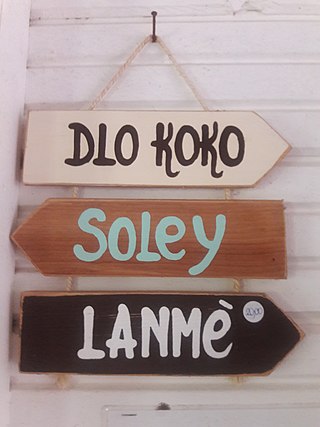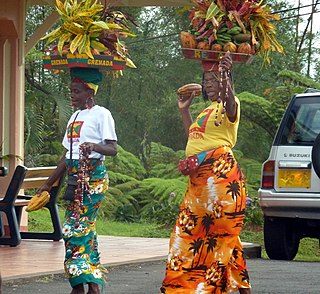Related Research Articles

This article is a demography of the population of Grenada including population density, ethnicity, education level, health of the populace, economic status, religious affiliations and other aspects of the population.

Creole peoples are ethnic groups formed during the European colonial era, from the mass displacement of peoples brought into sustained contact with others from different linguistic and cultural backgrounds, who converged onto a colonial territory to which they had not previously belonged.

The French West Indies or French Antilles are the parts of France located in the Antilles islands of the Caribbean:
Caribbean English is a set of dialects of the English language which are spoken in the Caribbean and Liberia, most countries on the Caribbean coast of Central America, and Guyana and Suriname on the coast of South America. Caribbean English is influenced by, but is distinct to, the English-based creole languages spoken in the region. Though dialects of Caribbean English vary structurally and phonetically across the region, all are primarily derived from British English and West African languages. In countries with a plurality Indian population, such as Trinidad and Tobago and Guyana, Caribbean English has further been influenced by Hindustani and other South Asian languages.

A Spanish creole, or Spanish-based creole language, is a creole language for which Spanish serves as its substantial lexifier.
In addition to its classical and literary form, Malay has various regional dialects. Also, Malay spread through interethnic contact and trade across the Malay Archipelago as far as the Philippines. That contact resulted in a lingua franca that was called Bazaar Malay or low Malay and in Malay Melayu Pasar. It is generally believed that Bazaar Malay was a pidgin, influenced by contact among Malay, Hokkien, Portuguese, and Dutch traders.

Antillean Creole is a French-based creole that is primarily spoken in the Lesser Antilles. Its grammar and vocabulary include elements of French, Carib, English, and African languages.
Virgin Islands Creole, or Virgin Islands Creole English, is an English-based creole consisting of several varieties spoken in the Virgin Islands and the nearby SSS islands of Saba, Saint Martin and Sint Eustatius, where it is known as Saban English, Saint Martin English, and Statian English, respectively.
Anguillan Creole is a dialect of Leeward Caribbean Creole English spoken in Anguilla, an island and British Overseas Territory in the Caribbean. Although classified as a dialect of Leeward Caribbean Creole English spoken in Saint Kitts and Nevis, Antigua and Montserrat due to a common British colonial history, it is actually closer to the British Virgin Islands and Saint Martin varieties of Virgin Islands Creole. The number of speakers of Anguillan Creole is below 10,000. Anguillan Creole does not have the status of an official language.

The official languages of the Caribbean island-state of Aruba are Papiamento and Dutch, but most Arubans speak a minimum of four languages, including English and Spanish. Schools require students to learn English, Spanish and to a lesser extent French. According to the Government of Aruba the mother tongue and primary vernacular of almost all Arubans is Papiamento, an Afro-Portuguese Creole language spoken since the 16th century. The language, however, was not widespread in Aruba till the 18th and 19th centuries when most materials on the island and even Roman Catholic schoolbooks were written in Papiamento.
An English-based creole language is a creole language for which English was the lexifier, meaning that at the time of its formation the vocabulary of English served as the basis for the majority of the creole's lexicon. Most English creoles were formed in British colonies, following the great expansion of British naval military power and trade in the 17th, 18th and 19th centuries. The main categories of English-based creoles are Atlantic and Pacific.
The 'Southern Caribbean is a group of islands that neighbor mainland South America in the West Indies. Saint Lucia lies to the north of the region, Barbados in the east, Trinidad and Tobago at its southernmost point, and Aruba at the most westerly section.
The languages of North America reflect not only that continent's indigenous peoples, but the European colonization as well. The most widely spoken languages in North America are English, Spanish, and to a lesser extent French, and especially in the Caribbean, creole languages lexified by them.
Indo-Grenadians or Grenadians who trace their roots to India, form the largest minority group in Grenada. This term is not generally recognized by Grenadians or indeed Caribbeans. They usually refer to themselves simply as Grenadian or possibly Caribbean. This group was first introduced during the second half of the 19th century when Grenada experimented with indentured labour. By the second half of the 20th century Indians were so integrated into Grenada’s society that a distinct Indian cultural identity was generally invisible. In addition, Indians were involved in every aspect of Grenadian life. Currently there are over 12,000 Grenadians of Indian and mixed-Indian descent.

Grenada is an island country in the West Indies in the Caribbean Sea at the southern end of the Grenadines island chain. Grenada consists of the island of Grenada itself, two smaller islands, Carriacou and Petite Martinique, and several small islands which lie to the north of the main island and are a part of the Grenadines. It is located northwest of Trinidad and Tobago, northeast of Venezuela and southwest of Saint Vincent and the Grenadines. Its size is 348.5 square kilometres (134.6 sq mi), and it had an estimated population of 124,523 in July 2021. Its capital is St. George's. Grenada is also known as the "Island of Spice" due to its production of nutmeg and mace crops.

Afro-Grenadians or Black Grenadians are Grenadian people of largely African descent. This term is not generally recognised by Grenadians or indeed Caribbeans. They usually refer to themselves simply as Black or possibly Black Caribbean. The term was first coined by an African Americans history professor, John Henrik Clarke (1915–1998), in his piece entitled A Note on Racism in History. The term may also refer to a Grenadian of African ancestry. Social interpretations of race are mutable rather than deterministic and neither physical appearance nor ancestry are used straightforwardly to determine whether a person is considered a Black Grenadian. According to the 2012 Census, 82% of Grenada's population is Black, 13% is mixed European and black and 2% is of Indian origin.
Grenadian Americans are Americans whose ancestry came from the Caribbean island of Grenada, or Grenadians who have American citizenship. Since 1984, nearly 850 Grenadians arrive legally in the United States each year, and the number of Grenadian Americans was 25,924 in 2000. They began immigrating to the US primarily from 1950. Between 2007 and 2011, there were approximately 30,320 Grenadian-born residents in the United States.
Dominican Creole French is a French-based creole, which is a widely spoken language in Dominica. It can be considered a distinct dialect of Antillean Creole.
Grenadian Creole is a variety of Antillean Creole. In Grenada and among Grenadians, it is referred to as Patois.
References
- ↑ Grenadian Creole English at Ethnologue (18th ed., 2015) (subscription required)
- ↑ Ethnologue report for Southern
- ↑ Ethnologue report for language code:gcl
- ↑ Grenada – History
- ↑ French Creole in Grenada
- 1 2 Chase, Thomas R.; Chase, Zarah A. (2018-01-30). Abridged Handbook of Grenadian Creole English and French Names: A Dictionary of Grenadian Creole English with Grammar & Syntax. AuthorHouse. ISBN 978-1-5462-1688-9.